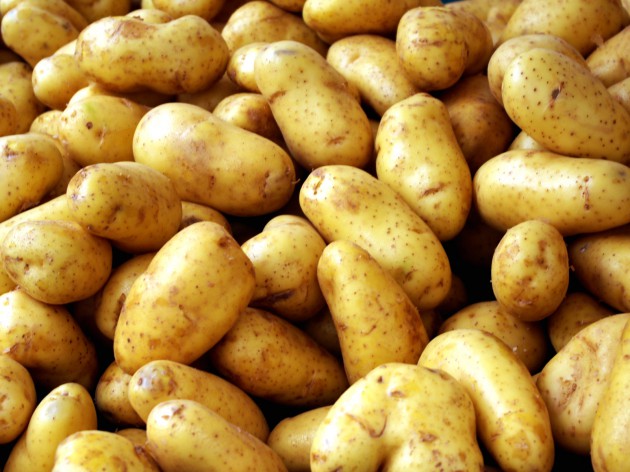Why sack potatoes are disappointing

 This week at the market.
This week at the market.
In this article we are zeroing in on sack potato production. But first of all an overview of the market at Mbare Musika this past week: The position remains largely unchanged from our update last week with tomatoes dominating the market. Generally all the usual vegetables and fruits are available. There is a glut of carrots which are highly affordable and this is a good time to buy for processing through dehydration, pickling, freezing and any other preservation methods favoured.
Potato Production in Zimbabwe
Over the years, potato has become one of the most popular crops in Zimbabwe with every sector from small to large-scale farmers getting in on the act. This has been encouraged by eating habits that are gradually changing as maize is no longer staple food for many urban households.
While in Zimbabwe and other developing countries potato seed is a preserve of private companies and research institutes, in Peru, where the potato originated, farmers hold the bulk of potato seed varieties. In Zimbabwe, seed production is centred in the eastern highlands where climate conditions are most favourable.
Potatoes are major sources of Vitamin A, Vitamin C, carbohydrates and proteins. While most people prefer fried chips served in fast food outlets, potatoes can also be eaten boiled, mashed and roasted.
Potato at the Market (Mbare)
At Mbare market plus or minus 100 tonnes of potatoes are delivered daily. The main sources are Manicaland, Mashonaland East, Central and Mashonaland West provinces. For the past two months, prices at the market have been firm due to a number of factors including consistent demand and supply.
As of Thursday, prices were ranging from $4-$10 per 15kg pocket depending on grade and size. The 2013/14 crop assessment report recently issued by the Ministry of Agriculture, Mechanisation and Irrigation indicates an increase in potato production by 6 percent to 397 600 tonnes from last year’s 374 600 tonnes.
Sack Potato Production
Controversy has surrounded the effectiveness of growing potatoes in sacks with many first time farmers harvesting poor yields. The sack potato farming method, done over a 128-day cycle, was received with excitement last year after some “agriculturalists” claimed it was possible to produce 15kg of potatoes per plant. However, for most farmers who embraced this message, results were less than satisfactory.
eMkambo gathered the following factors which could have contributed to poor achievements around sack potato production:
1. The number of the tubers produced by each plant as well as the maximum weight per tuber which is influenced by agronomic and varietal potential. The more the number of tubers the smaller they become. Each of the potato variety has a yield potential which are determined by nature. Even if feeding is optimal yield will not go beyond the potential. The variety which is commonly grown by farmers in Zimbabwe is BP 1 with a yield potential of less than 2kgs per plant. Putting it in a sack will not up that figure.
2. Half the number of the potato tubers is formed at the first node (node at the base) and the other half is formed at the next five nodes. There is no need to continue to fill the sacks beyond the 6 nodes. Even if the sacks were filled the potatoes will not form tubers beyond the first 6 nodes.
3. Potatoes reach maturity between 70- 100 days after emergence depending on the variety. Even if you continue filling sack and watering after this time the potato may remain green but it will not continue to produce any tubers.
4. Low nitrogen and high sucrose levels in the potato plant favors the formation of tubers. High fertilizer rates were applied and some farmers applied compound D and AN, which are not recommended in root crops as they promote above ground growth at the expense of tubers.
5. Optimal soil temperatures for potato growth are between 15 and 20C. The potato tuber is an enlarged portion of the stolon. The initiation of this tuber is triggered by short day lengths (photoperiods), and involves growth hormones. The colder the soil temperature, the more rapid the initiation of tubers and the greater the number of tubers formed. The sacks which were used were made of polythene like material and some lined with plastic and there is a possibility that they caused increased temperatures which slow down the initiation of tuber formation.
6. The ideal potato soils are well-structured with good drainage allowing proper root aeration and tuber development with minimum disease infestation. The sack disturbed the drainage resulting in poor aeration of the roots.
7. Potatoes prefer soil pH of 5.5-7. A low PH means some nutrients become unavailable. Potatoes are prone to scab when grown in high pH soils therefore it is advised that lime should be applied about six months before planting. This makes it impossible to lime potatoes in sacks. Low PH potatoes suffer from Aluminium and heavy metal ion toxicity as well as restricted potassium and magnesium utilization. All this affect growth and compromise the final yield. No pH adjustment was done in sack potato production.
8. More vigilance should be exercised when watering potatoes. The soils should not be wet but damp and there should be uniform moisture in the soil. It is very difficult to have uniform moisture in sack and the difference in moisture can affect the cooling of the soil resulting in the promotion of knobs which are caused by secondary growth. Potatoes grown in sacks are likely to have deformed shape resulting in poor quality and affecting marketability.
More insights can be obtained through eMKambo Call Centre mobile numbers: 0772 137 717/0772 137 758/0716 331 140-5/ 0771 859 000-5/0739 866 343-6. Email: [email protected], [email protected], [email protected], [email protected] .










Comments